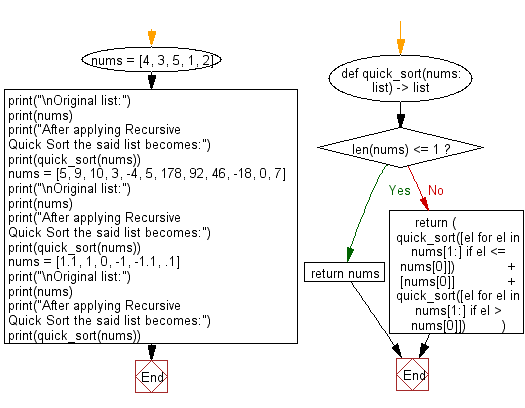Python: Sort unsorted numbers using Recursive Quick Sort
28. Recursive Quick Sort
Write a Python program to sort unsorted numbers using Recursive Quick Sort.
Quicksort is a divide and conquer algorithm. It first divides the input array into two smaller sub-arrays: the low elements and the high elements. It then recursively sorts the sub-arrays.
Sample Solution:
Python Code:
def quick_sort(nums: list) -> list:
if len(nums) <= 1:
return nums
else:
return (
quick_sort([el for el in nums[1:] if el <= nums[0]])
+ [nums[0]]
+ quick_sort([el for el in nums[1:] if el > nums[0]])
)
nums = [4, 3, 5, 1, 2]
print("\nOriginal list:")
print(nums)
print("After applying Recursive Quick Sort the said list becomes:")
print(quick_sort(nums))
nums = [5, 9, 10, 3, -4, 5, 178, 92, 46, -18, 0, 7]
print("\nOriginal list:")
print(nums)
print("After applying Recursive Quick Sort the said list becomes:")
print(quick_sort(nums))
nums = [1.1, 1, 0, -1, -1.1, .1]
print("\nOriginal list:")
print(nums)
print("After applying Recursive Quick Sort the said list becomes:")
print(quick_sort(nums))
Sample Output:
Original list: [4, 3, 5, 1, 2] After applying Recursive Quick Sort the said list becomes: [1, 2, 3, 4, 5] Original list: [5, 9, 10, 3, -4, 5, 178, 92, 46, -18, 0, 7] After applying Recursive Quick Sort the said list becomes: [-18, -4, 0, 3, 5, 5, 7, 9, 10, 46, 92, 178] Original list: [1.1, 1, 0, -1, -1.1, 0.1] After applying Recursive Quick Sort the said list becomes: [-1.1, -1, 0, 0.1, 1, 1.1]
Flowchart:

For more Practice: Solve these Related Problems:
- Write a Python program to implement quick sort recursively and print the pivot at each recursion level.
- Write a Python script to perform recursive quick sort on a list and then output the sorted list along with recursion depth.
- Write a Python program to modify recursive quick sort to choose the median as the pivot and compare the number of comparisons.
- Write a Python function to implement recursive quick sort on a list of strings and ensure the sort is case-insensitive.
Go to:
Previous: Write a Python program to sort unsorted numbers using Stooge sort.
Next: Write a Python program to sort a given collection of numbers and its length in ascending order using Recursive Insertion Sort.
Python Code Editor:
Contribute your code and comments through Disqus.
What is the difficulty level of this exercise?
Test your Programming skills with w3resource's quiz.
